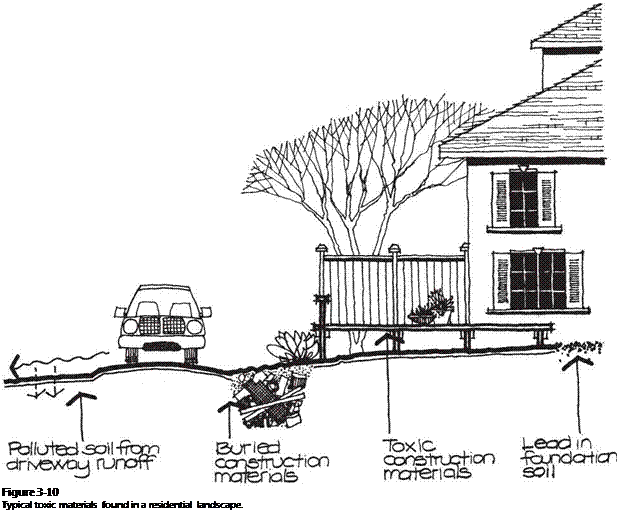As already mentioned, some landscapes suffer from the presence of toxic materials in the soil or in structural materials (Figure 3—10). Newly built houses often have construction debris that has been left behind in various areas of the site or even buried out of sight in the ground. All of this must be removed, with special care given to paints, glues, chemical solvents, and so on. These should be separated from inert construction materials and taken to a local or regional hazardous waste collection facility.
Lead is a common soil pollutant in older urban landscapes, especially near the foundation of structures where lead-based paint has chipped and fallen to the ground. Heavy metals, oil, and other contaminated materials are also possible from dumping in earlier years when there was little knowledge about the potential harm of such materials. Locations near the back of older properties or garages should be carefully examined for the presence of such toxic substances. All these materials need to be carefully removed from the residential site after consultation with the proper government agencies such as state EPA or municipal health offices to determine how to remove and transport such materials. Polluted soil can be placed in tight, leakproof containers and taken to a local or regional collection point for toxic materials. Never put polluted soil or contaminated waste materials with other construction debris or household garbage.
Another source of toxic materials is pressure-treated wood used in decks, fences, and other site structures before 2003. Such wood usually contains chromated copper arsenate (CCA) as a preservative, a substance that is a known toxin. In the perfect world, all such wood should be removed and replaced by less toxic treated wood that is currently available (also see “Use Toxin-Free Materials” in “Healthy Environment” in this chapter). Cost and other practical considerations typically make this unrealistic. However, pressure-treated wood that is touched and used by children or is located where the chemicals can directly leach into wetlands, streams, or ponds should be replaced despite costs. Consult the state EPA or local health department to determine
 |
how best to dispose of CCA-treated wood in your area. Pressure-treated wood that is to remain can be periodically coated with an oil-based penetrating stain to help seal in preserving chemicals.



